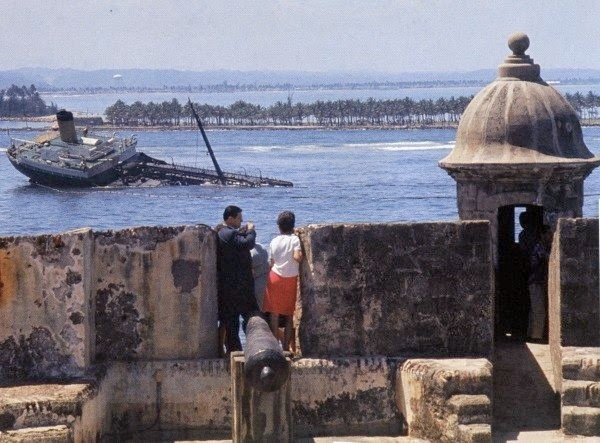Cheito woke up early, before sunrise. He made himself a
breakfast of cornflakes, buttered toast and orange juice. He brushed his teeth,
put on his jeans, a t-shirt and his sneakers. He packed his mask, snorkel,
fins, trunks, towel and spear gun in his duffel. He had told his mother at
dinner the previous night that he was going to the beach the following morning, "Cheito", she said, "make sure you let yourself out of the house quietly." The early morning was
damp, dark and windy. The lightening sky was heavy with clouds. He draped the
duffel over his back and hiked up Calle Mejico to the corner Lomas Verdes and
Glasgow. He waited 15 minutes and the first bus soon arrived. He climbed aboard
and fed his quarter to the turnstile and made his way to one of the hard
plastic seats. The bus was empty except for a couple of older women who got off
at the Medic al Center stop. The route read like a history of his Island. He
rode the bus on Jose de Diego Avenue past San Patricio and Jesus T. Piñeiro
Avenues until he got to the corner of De Diego and Franklin Delano Roosevelt
Avenue. He then transferred to the number 2 bus, down Juan Ponce De Leon Avenue
and back on De Diego, where he transferred to the number 5 bus, which finally
took him on the Roman Baldorioty de Castro Expressway to Isla Verde. He got off
at the Corner of Tartak Street and Isla Verde Avenue, hiked around the corner
and knocked on the door of 8158 Tartak. His buddy, Luis Gonzalez, "Lapa", to his friends, opened the door after a few
seconds. He stepped inside, and after a mumbled greeting, he asked Lapa directions
to the bathroom so he could change into his swimming gear. In swimming trunks
and t-shirt, with gear in hand, the boys walked back down Tartak to Isla Verde,
turned right and then left onto Dalia Street all the way to the end where the
street ended on the beach. The beach was empty, and the trash of the Friday
night revelers was strewn about. To the left was a sea wall, where they hid
their shirts and shoes. It was now day light, but barely so. The sky was gray,
and so was the sea. A fresh breeze stirred up a light chop on the water’s
surface. Waves were breaking on the Isla Verde reef a couple of hundred of
yards off the beach. Visibility in the water was going to be poor. He already
felt chilled. Cheito and Lapa cleaned out and donned their masks and flippers, grabbed
their spear guns, and waddled into the dancing surf. They swam in tandem to the
reef, and after about 10 minutes or so, carefully avoiding the black spiny sea
urchins, climbed on the rocks on the leeward side of the islet to rest and
regroup. The boy had a cheap, old, but reliable diving watch his father had
bought on a trip to St. Thomas. They agreed to meet up again in about an hour
on the same spot. They plunged back into the water and went on separate ways. Cheito worked his way into deeper water, cocked the slings of his spear gun, and
started swimming around the reef in a clockwise direction. He was in about 15
feet of water and could barely make out the sea fans and stag horn coral on the
bottom. An occasional wave covered his snorkel, and he sputtered and coughed
away the briny water. There were a few wrasses and sergeant fish swaying in the
current, but no fish worth shooting. At times, he thought he saw silver flashes
out of the corner of his eye, at the edge of his vision, jacks or chubs
perhaps, but always out of range. He swam an irregular course, often checking
his position against the island. He was getting more and more chilled, and
decided to call it a day, swim to the reef, and huddle on the rocks to wait for
his friend. Past the field of urchins, careful to avoid the spines and the
occasional fire coral, he slowly clambered onto the worn coral of the island,
and sat there shivering. After a bit, Lapa returned, without fish, as
unlucky as he had been. They sat for a bit looking out to sea. They climbed
back into the water and swam back to shore. They found their towels and shoes,
dried off and headed back down Dalia to Isla Verde Avenue. At Tartak and Isla
Verde, they stopped at the open air diner. Cheito had enough money for a coke and a
bocadillo, and the ride back to Guaynabo. The sun finally peeked out of the
clouds, and they sat at their stools, warming themselves and eating their
lunch. He would have preferred to be lunching on fresh fish. Not today, maybe the next time.
Jose M. Caldas, March, 28, 2014.















